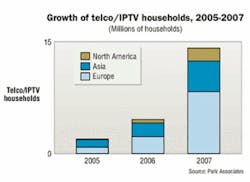Internet Protocol Television gaining ground and attention
Although the U.S. is far behind the rest of the world in IPTV deployment, the infrastructure to support it is beginning to gain momentum.
While video over twisted-pair has been around for several years, featuring either baluns or IP-based cameras in closed video surveillance applications, Internet Protocol Television (IPTV) is not something that most Americans are familiar with or enjoying at home. In fact, more than 90% of the approximately 14 million IPTV subscribers reside in Europe and Asia.
IPTV is a fairly simple and cost-effective tech-nology, but the infrastructure and business models to support it in North Amerca must be in place first for it to sustain significant growth.
What is it? How does it work?
IPTV is the delivery of broadcasted television service over service provider networks in the form of IP packets. When the IP packets reach the customer location, a set-top box decodes the packets and enables viewing on a television.
IPTV and Internet TV are often confused; they are not the same. IPTV is a secure, closed system with content that is managed by the service provider, with strict quality of service requirements and a high-definition entertainment experience. Internet TV is the streaming of video from the Internet with limited viewing options and reduced quality, much likewhat you see on YouTube or ChannelChooser.
In addition to providing live TV broadcasting, IPTVis a 2-way service that offers the possibility of an on-demand experience. “The Internet has proven thathuman beings would rather have an individual experience geared towards our needs and preferences versus TV as we know it, which offers a single experience whereeveryone has access to the same channels, the same content, and on the same time schedule,” says Ervin Leibovici, CEO for BitBand (www.bitband.com), provider of video delivery solutions via IP networks. “The program I want to see is probably different than what the next-door neighbor or someone across the country wants to see.”
Rather than transmitting directly to the home via cable or satellite, IPTV broadcasted signals are transmitted to a service provider’s local central office where they are turned into IP data packets, stored, and indexed for searching andaccess by the customer. Only then are the IP packetsdelivered to the customer’s set-top box.
“It’s like putting a buffer between the content source and the consumer, which basically consists of theoperator’s IP network storing and handling the content in order to provide a personalized on-demandexperience,” says Leibovici. “The 2-way nature of IPTV technologyalso allows the service provider to gather information about what type of content is most popular per customer or region, predict consumption based on the statistics, and then optimize performance and bandwidth usageby distributing that content locally where it can be served quicker to the customer.” (BitBand offers content distribution network technology that enables this practice.)
Service providers, such as AT&T or Verizon, can provide IPTV service to residential customers. But it is also a growing trend in the hospitality industry and for some hospitals. These venues want to offer personalized TV service to their patients and guests, and they can do so by locally housing the same type of equipment used by service providers.
“In this scenario, you can almost think of the hotel chain or hospital as the service provider and the guests or patients as the residents,” says Leibovici. “A chain of hotels can also centrally manage their equipment and content for the entire chain and then deliver the right content applicable to thatarea. The biggest difference between this application and the service provider model is that the customers change daily,resulting in a larger variety of content being viewed and the inability to offer content based on preferences or success-fully predict future use.”
Infrastructure requirements
The bandwidth required for today’s IPTV ranges between 2 and 3 Mbits/sec per TV for standard definition video, which uses MPEG-4 as the compression method. High-definition (HD) TVs require even more bandwidth, jumping the requirements to 10 Mbits/sec or higher per TV. With many consumers having more than one TV in the home, these bandwidth requirements are far above the low kilobytes per second for voice or1 to 3 Mbits/sec speeds for Internet access provided overexisting service provider networks. Consequently, infrastructures must be upgraded to support more bandwidth, espec-ially since the number of consumers with HDTV is expected to grow rapidly over the next 10 years.
“AT&T and Verizon are investing billions in laying fiber and increasing bandwidth to get IPTV up and running in the U.S.,” says Kurt Scherf, vice president and principal analyst for Parks Associates (www.parksassociates.com), an international market research company specializing in emerging consumer technology products and services. “Their main competition is thecable TV companies that use primarily coax distribution in the last mile, creating a bottleneck.”
In addition to sufficient bandwidth, IPTV networks must support multicasting to provide both on-demand and traditional live TV. Multicasting allows data to be sent only once from the source to multiple destinations. In contrast, the on-demand experience relies on unicasting, which is a one-to-one connection between theserver at the service provider location and the customer’s set-top box. With unicasting, the customer receives a districtvideo stream only when they request it.
“Human beings don’t like change, so while we are willing to try new things in a gradual way, we don’t want to neces-sarily dump the live TV-watching experience that we havehad for nearly 70 years,” says BitBand’s Leibovici. “As aresult, IPTV service providers need to offer both an on-demand experience and live broadcasting where everyonesees the same program on a given channel.”
Updating service provider networks to deliver sufficient bandwidth to the customer location is of more concern than being able to deliver IPTV within the premise environment. According to Leibovici, hotels and hospitals that want todeliver IPTV service must have a minimum of Category 5cabling. With most new installations deploying Category 6or Category 6A, delivering IPTV service throughout a premise environment won’t likely be the problem.
In addition to laying miles of fiber and updating outside-plant infrastructures to ensure sufficient bandwidth, IPTV providers will also have to ensure quality if they want to compete with cable TV companies and each other. “Sometimes, there are instances when the picture is disrupted by little squares that appear on the screen, and that is something that we fix with our IPTV solutions,” says Leibovici.
Another element to validating IPTV quality is how quicklyusers can change channels, referred to as channel zapping.Acceptable channel zapping is typically considered to be one second or less, but according to Leibovici, the delay for some HDTV signals can be 5 or 10 seconds.
“To minimize required bandwidth for HDTV, the video stream is divided into frames,” explains Leibovici. “There are full frames and additional frames that only include the changes to the full frame. The full frames are spread further apart, and as the customer changes the channel, they have to wait until that next full frame is available. Our technology overcomes the channel zapping delay by offering an analog type of sub-second zapping environment.”
Out of step with the world
The 1.2 million IPTV subscribers in the U.S. represent a small sliver of the 14 million subscribers worldwide, and that number pales in comparison to cable and satellite TV services that reach some 90 million U.S. households. Experts cite many reasons for the U.S. being at least five years behind the rest of the word in IPTV deployment, ranging from lack of infrastructure and varying business models to demographics and cultural differences.
“Back in the 1990s, companies were laying a lot of fiber, but it was mostly for backhaul applications, and not enough was laid closer to the home,” says Scherf. “AT&T and Verizon, whichaccount for over one million of the 1.2 million U.S. subscribers, have taken a lot of time updating their infrastructures. Plus, they have well-established partnerships with satellite companies like DirectTV, which have allowed them to offer triple-play services and compete with cable.”
In Europe, the many providers that compete to offer IPTV as part of their triple-play offerings have had to lower prices and enhance quality and service to ensure return on investment (ROI). “In the U.S., we have a very different business model; it’s essentially two giants and bunch of little guys that are not in the same area,” says Scherf. “I don’t think that AT&T and Verizon want to emulate what Europe has done.”
Scherf explains, “In Europe, fiber is not traditionally laid as close to home as what AT&T and Verizon are currently doing. They’ve relied mainly on ADSL2+ and VDSL technology that deploys channel-bonding technology. Even though Europe led the way in IPTV, they are now taking a cue from the U.S. and realizing that they can offer a lot more services by laying fiber closer to the home.”
Demographics also play a role, with the U.S. having many more people in private homes spread out away from metropolitan areas. “It’s difficult to justify laying the infrastructure to reach these homes, yet at the same time, these are the homes owned by the people willing to adopt and spend the money for new services,” says Leibovici. “It’s also a cultural issue. The U.S. has been slow to adopt new technology. We saw this with cellular telephony service, which is far superior in Europe.”
Despite the U.S. being behind in IPTV, both Scherf and Leibovici view it as growing market with much potential. “Once the U.S. gets serious about a technology, they adopt if very quickly,” says Leibovici.“Cable companies should be very alert and begin investing in IPTV, because they’re not going to have a lot of time to react. Another 400 million subscribers are expected in the next 10 years, and in another 3 to 4 years, I expect huge growth in the U.S.”
Scherf concurs, “In terms of percentage growth in IPTV, the U.S. is actuallynear the top of the market. There wereonly 300,000 subscribers at the end of 2006, and now there are 1.2 million, which is significant growth. And given the business models that U.S. service providers are following, we’ll likely show a much quicker ROI than other areas of the world.”
A marriage for better or worse?
Leibovici believes that Internet Protocol that will eventually win out: “The world has already made the decision that IP is the most cost-effective means of delivering data across networks. Plus, the protocolitself is very flexible and allows for effective transfer and handling of data.”
He adds, “The only technology that can marry TV and the Internet is IP, but it remains to be seen if the two will be combined in one device. The Internet is a very individual tool while the TV is a family device. For the two to merge into one, I believe the world would have to become less friendly with individualist in their own corners, and that would be very sad. On the other hand, IPTV alone could have a social contribution where people are more family oriented, which is almost as significant as its economic contribution.”
BETSY ZIOBRON is a freelance writer and regular contributor to Cabling Installation & Maintenance. She can be reached at: [email protected]



